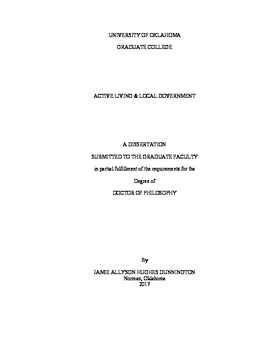| dc.description.abstract | Purpose: This qualitative study explored a local government’s perceptions of and support for active living and factors that influenced active living decisions and collaboration in one metropolitan city in the southern region of the United States. Methods: City leaders and municipal employees (n=46) were interviewed. Participants had a role in creating and implementing policies and infrastructure changes that impact physical activity behaviors of city residents. They included the mayor, seven city council members, the city manager, the assistant city manager, fifteen director- and management-level city employees, six public health practitioners, six city planners, three parks and recreation employees, three pubic works employees, and three commissioners. The study took place in a car-dependent and car-prioritized city where physical inactivity is high, inadequate active living supportive policies have been adopted, and few walkable and bikeable areas exist. Interview transcripts were coded using NVivo and then analyzed for themes. Results: Regarding city leaders and active living decisions, five themes were identified: (1) identification of the most influential decision-makers, (2) barriers to making active living supportive design decisions, (3) city assets that facilitate making active living supportive design decisions, (4) younger generation preference, and (5) acknowledgement of particular co-benefits of activity-friendly environments. Regarding municipal employees and perceptions of active living, seven themes were identified: (1) perception of high level of support, (2) identification of the co-benefits of creating activity-friendly environments (3) comparison to other cities in the country, (4) ‘not there yet’ status, (5) acknowledgment of these changes being a long-term process, (6) importance of the mayor’s support, and (7) need for greater citizen involvement and demand. Regarding inter-governmental active living collaboration, eight themes were identified: (1) minimal active living/public health collaboration, (2) strained relationships with city planners, (3) radically different perceptions of planners, (4) the person matters, (5) facilitators to collaboration (history of working together, personal relationships, and regular meetings), (6) barriers to collaboration (silo-ed work environments and turf issues), (7) key decision-makers (the city manager, council, and mayor), and (8) inclusion of citizens in collaboration. Conclusions: These three studies add to the literature that explores the connection between local government and the promotion of physical activity. Findings increase understanding of multiple viewpoints of local government officials and the challenges and opportunities associated with creating activity-friendly policies and environments. Qualitative research can provide guidance to enhance collaboration and facilitate the creation of stronger partnerships and long-lasting policy and environmental changes. | en_US |
